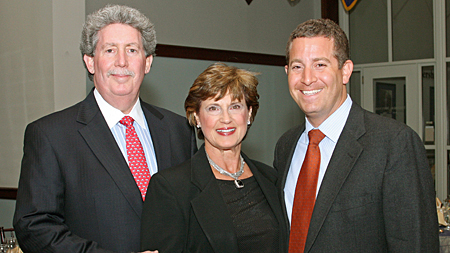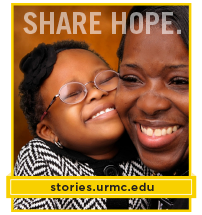February 2013
Benets Endow Professorship
in Finance
 Jay and Jeanne Benet with their son, Josh
Jay and Jeanne Benet with their son, Josh
Longtime supporter of the William E. Simon School of Business Jay S. Benet ’76S (MBA) has remained actively involved at his alma mater as a member of the Simon School’s National Council and Executive Advisory Committee. In appreciation for the outstanding leadership at Simon, Mr. Benet and his wife Jeanne have committed $1.5 million that will establish the Jay S. and Jeanne P. Benet Professorship of Finance.
“We are deeply grateful to Jay and Jeanne Benet for this investment in finance education at the Simon School,” said President Joel Seligman. “We are proud to be considered a global leader in finance education, and this gift will help us to build on that momentum.”
The Benet’s gift contributes to the Simon School’s $85 million campaign, which is part of The Meliora Challenge: The Campaign for the University of Rochester and its $1.2 billion goal. Their gift is also one of 60 endowed professorships that have been established since the beginning of the Campaign, which seeks to reach 80 new endowed professorships by June 30, 2016.
By endowing this professorship, the Benets are providing Simon with the resources to continue to attract renowned faculty from around the world and remain a leader among its peers in finance. Mr. Benet has also committed to ongoing support of the University as a Charter Member of the George Eastman Circle at the Benefactor level.
“This gift of a finance professorship for the Simon School is in recognition of the outstanding education I received while attending Simon,” said Mr. Benet. “The analytic, fact-based problem-solving skills I learned from my professors enabled me to successfully compete in business.”
That success has helped Mr. Benet become vice chairman and CFO of The Travelers Companies Inc, where he oversees all of Travelers’ financial operations, including financial planning and analysis, enterprise risk management, and several other areas. He joined the company after 14 years at Coopers & Lybrand, now PricewaterhouseCoopers LLP, where he was a partner.
For more information, please click here.
Values and Action

Throughout The Meliora Challenge, our generous alumni, parents, and friends have honored others with their gifts. Often those who are honored are friends or loved ones, revered faculty, or exceptional care providers—people who have had a direct impact on their lives. Phil Saunders’ truly altruistic gesture, mentioned within this newsletter, is a reminder that there are those whose impact on our lives cannot easily be seen or felt.
The display honoring veterans of the U.S. Armed Forces in the Saunders Research Building acknowledges the men and women who have bravely served and selflessly sacrificed for our country. University of Rochester faculty, students, and alumni have served in the military as far back as the Civil War. Plaques hanging in Wilson Commons commemorate the lives that were lost in past battles.
Today, students are receiving training for service as commissioned officers in the United States Navy or Marine Corps through our NROTC program. Alumnus Rear Admiral Sean Pybus ’79 is still serving as a career Naval Special Warfare SEAL officer—some of you may have heard him speak at this past Meliora Weekend. And Donald Winter ’69, currently a member of the Washington, D.C. Regional Cabinet, served as the 74th Secretary of the U.S. Navy from January 2006 until March 2009.
These men and women have put their own lives in danger to protect the lives of others. I cannot think of a more admirable profession, and I am proud the University’s history contains so many who have chosen this path. The next time you are on the River Campus or at the Medical Center, I encourage you to visit these memorials.
Meliora!
James D. Thompson
Senior Vice President
Chief Advancement Officer
Thornton Installed as the Inaugural Saunders Distinguished Professor
 From left: Richard T. Moxley III, E. Philip Saunders, Charles A. Thornton, Dean Mark Taubman, and President Joel Seligman
From left: Richard T. Moxley III, E. Philip Saunders, Charles A. Thornton, Dean Mark Taubman, and President Joel Seligman
Today, more than 28 million Americans are coping with neuromuscular diseases, which include Parkinson’s disease, multiple sclerosis, and muscular dystrophy, among others. As the population continues to grow and age, this number will continue to increase.
Charles A. Thornton ’91 (Flw) has dedicated his career to understanding the causes of these devastating degenerative diseases and developing treatments for them, opening the door to revolutionary new therapies. On February 7, Thornton was installed as the inaugural Saunders Family Distinguished Professor in Neuromuscular Research.
Family, friends, colleagues, and University leaders filled the atrium of the Saunders Research Building at the University of Rochester Medical Center to acknowledge Thornton’s excellence in neuromuscular care and research and to recognize the building’s namesake E. Philip Saunders for his vision and transformational philanthropy.
"I want to thank Phil Saunders for his generosity and recognize that it is not just his generosity that we are lauding tonight; it’s also his character," said President Joel Seligman. "Phil is one of the most principled people I know. He is a person of unquestioned integrity and honesty. He is the kind of person we all want to be."
Saunders’ interest in neuromuscular disease research began in 1988 when his daughter, Patty, had a severe attack of Guillain-Barre syndrome. Patty’s physician was Director of the Neuromuscular Disease Center Richard T. Moxley III, Helen Aresty Fine and Irving Fine Professor in Neurology. After her treatment, Saunders developed a close friendship with Moxley and became a passionate supporter of the neuromuscular program. In 2011, he made one of the largest gifts in the history of the Medical Center in support of research programs in muscular dystrophy, cancer, and translational medicine. The Saunders Family Distinguished Professorship in Neuromuscular Research was part of that gift.
A link also exists between Moxley and Thornton. The year after meeting Saunders, Moxley received a call from a physician at the University of Zimbabwe School of Medicine who was interested in the neuromuscular fellowship being offered at the Medical Center. That physician was Thornton, who spent two years abroad serving as a Fulbright scholar. Since joining the faculty in 1991, he has become one of the most knowledgeable and revered muscular dystrophy specialists in the country.
“Charles epitomizes the translational scientist,” said Mark Taubman, dean of the School of Medicine and Dentistry. “His current work is taking advantage of exciting new developments in RNA biology to provide novel approaches to crippling diseases. And as an active clinician, he is ideally suited to be able to take results from the lab to the patient, which is exactly the work being done in the Saunders Research Building.”
Professor of neurology and a scientist in the Center for Neural Development and Disease, Thornton teaches students, residents, and fellows about genetics and the roots of and potential treatments for neurological diseases. He also helps patients and families affected by disorders such as muscular dystrophy as co-director of the Medical Center's Wellstone Muscular Dystrophy Cooperative Research Center, one of the world's top centers for treatment of the disease.
Saunders Recognizes Our Nation’s Heroes

E. Philip Saunders, Bradford C. Berk, Jeff Bazarian (back) with officers and cadets of the NROTC program
“Let us never forget the sacrifices made by our veterans and their families, and may the research within this building bring healing to them and others.”
These are the encouraging words of accomplished entrepreneur
E. Philip Saunders, now immortalized on the new memorial display in the Saunders Research Building to honor veterans of the U.S. Armed Forces. The display, unveiled during a dedication ceremony in the building’s atrium on January 31, serves as a reminder of the sacrifices made by those serving in our country’s armed forces and as inspiration to those pursuing research at the Medical Center.
“I want to thank Phil for his dedication to our veterans and making sure that they are never forgotten,” said Bradford C. Berk ’81M (MD), ’81M (PhD), University senior vice president for health sciences and CEO of the Medical Center. “His generosity is an inspiration and I am confident that the discoveries produced in this building will help improve the lives of not only our veterans but countless other people across the globe.”
Recognition of our nation’s heroes was Saunders' request when he made one of the largest commitments in Medical Center history. With his $10 million gift in April 2011, Saunders provided transformational support to research programs in muscular dystrophy, cancer, and translational medicine. To recognize this visionary gift and Saunders' decades of support for research at the Medical Center, the new building for the Clinical and Translational Science Institute building was named in his honor.
Remarking upon the devastating and all-too-common brain injuries in veterans, Jeff Bazarian ’87M (MD), ’02M (MPH), P’13, an emergency physician and traumatic brain injury researcher, noted the significance of Saunders' gift.
“This building is a symbol, a beacon, a message,” said Bazarian. “And the message is this: the University of Rochester is serious about bringing research findings discovered at the bench to people in order to improve the human condition; we are serious about translating basic science discoveries into cures.”
In addition to being among the Medical Center’s most generous benefactors, Saunders has provided leadership through his service on the executive committee of The Meliora Challenge: The Campaign for the University of Rochester and as co-chair for the Medical Center’s campaign. He is also chair of the Rochester Leadership Council for the George Eastman Circle, of which he is a member at the Patron level.







 View Printer Friendly Version
View Printer Friendly Version